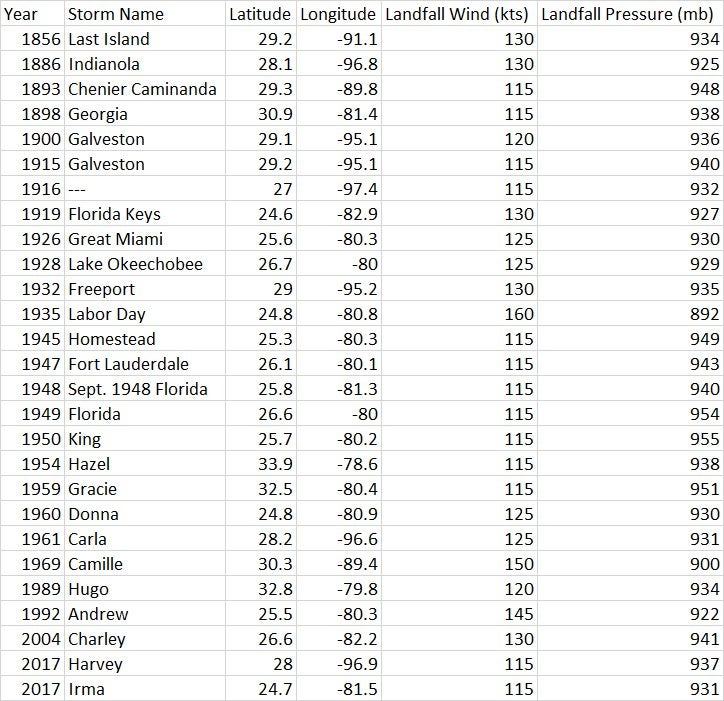Potentially Catastrophic Hurricane Michael Nearing Landfall in Florida Panhandle
October 10, 2018, 12:06 PM EDT
Hurricane-force wind gusts, torrential rains, and a massive storm surge are belting Florida’s Panhandle as extremely dangerous Hurricane Michael closes in on an afternoon landfall. At 11:30 am EDT, the hurricane hunters found that Michael was still intensifying, with sustained winds of 150 mph and a central pressure of 923 mb. A storm surge of over seven feet was already affecting the Panhandle, inundating many escape routes. Michael is poised to be one of the most top-ten most intense hurricanes on record to make landfall in the U.S.
If you are in the hurricane’s impact zone, now is the time to hunker down in your safe shelter and not be out driving. Remember that winds are stronger the higher up you go; if you are sheltering in a high-rise building, the lower floors will be safer than the upper floors. According to the National Hurricane Center’s classification of Category 4 wind damage, this is what can be expected where the eastern eyewall of Michael comes ashore:
Catastrophic damage will occur: Well-built framed homes can sustain severe damage with loss of most of the roof structure and/or some exterior walls. Most trees will be snapped or uprooted and power poles downed. Fallen trees and power poles will isolate residential areas. Power outages will last weeks to possibly months. Most of the area will be uninhabitable for weeks or months.
At 12:12 pm EDT, the storm tide at Apalachicola was 6.03’ above high tide (Mean Higher High Water, or MHHW), which was the second highest water level on record there. Only Hurricane Dennis of 2005 (a 6.43’ storm tide) brought higher water levels. NHC is predicting a storm surge as high as 14 feet for this portion of the coast.
NOAA buoy 42039, located about 90 miles (145 km) south-southwest of Panama City, Florida, reported sustained winds of 60 mph (97 km/h) and a wind gust of 76 mph (122 km/h) at 5:50 am, before the buoy stopped transmitting data. The highest significant wave heights were 30.8 feet at 4:50 am EDT.
Tyndall Air Force Base, which is in position to receive the strongest right-front eyewall winds of Michael at landfall, reported sustained winds of 70 mph, gusting to 84 mph, at noon EDT. This measurement was taken at 30 meters, so is higher than the winds that would be reported from the standard 10 meter measuring height.
 |
| Figure 2. Table of landfalling mainland U.S. Category 4 and 5 hurricanes since 1851. Image credit: Dr. Phil Klotzbach. To convert from knots to mph, multiply by 1.15. Rounded to the nearest 5 mph, 115 knots = 130 mph, 120 knots = 140 mph, etc. |
This will be our last post on Michael until after landfall.Strongest U.S. landfalling hurricane on record so late in the year?
Landfalling Category 4 hurricanes are rare in the mainland U.S., with just 24 such landfalls since 1851—an average of one every seven years. (Category 5 landfalls are rarer still, with just three on record). Only four Category 4 hurricanes have made landfall in October or later, and just two of these made landfall later than October 10: Hurricane King (October 18, 1950 in Florida), and Hurricane Hazel (October 15, 1954 near the NC/SC border). Both hit with top winds of 130 mph. So, Michael has the potential to be the strongest U.S. landfalling hurricane on record so late in the year.
In records going back to 1851, only nine hurricanes have struck the Panhandle with Category 3 or stronger winds. The strongest were the 1882 Pensacola hurricane and 1975’s Hurricane Eloise, both of which came ashore with winds of 125 mph. Since 1900, there has been only one Category 4 or 5 landfall anywhere on the northern Gulf Coast (from Beaumont to Cedar Key): Category 5 Hurricane Camille in 1969.
Michael’s central pressure of 923 mb at 11:30 am EDT Wednesday makes it likely that the hurricane will hit land as one of the ten strongest storms in U.S. history. According to NOAA’s Hurricane Research Division, only three landfalling mainland U.S. hurricanes have hit at a lower pressure. All three were at Category 5 strength....MUCH MORE